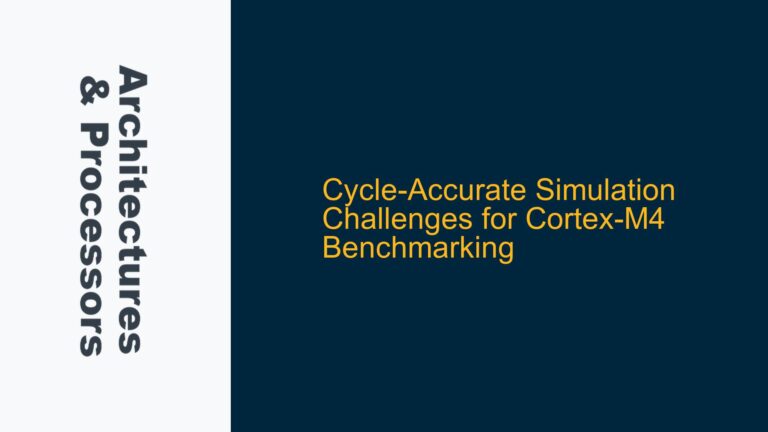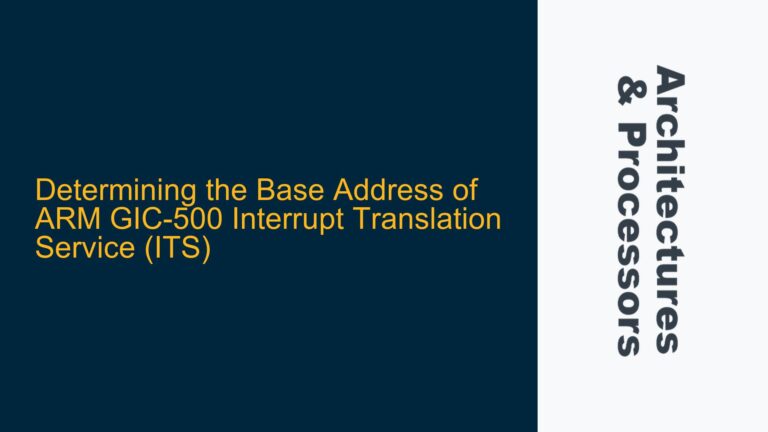ARMv7-M Floating Point Extension and Coprocessor Access Control
The ARMv7-M architecture incorporates a floating-point extension that relies on two coprocessors, CP10 and CP11, to manage floating-point operations. These coprocessors are controlled via the Coprocessor Access Control Register (CPACR), located at address 0xE000ED88. The CPACR register is critical for enabling or disabling access to the floating-point unit (FPU) and ensuring proper operation of floating-point instructions. Specifically, bits [23:20] of the CPACR are used to control access to CP10 and CP11. The ARMv7-M architecture mandates that these bits must be programmed identically for both coprocessors; otherwise, the behavior of the floating-point features becomes unpredictable.
The existence of two separate coprocessors, CP10 and CP11, raises questions about their purpose, especially since they must be programmed identically. This design choice is rooted in historical and architectural considerations, particularly compatibility with earlier ARM architectures and the evolution of the Floating-Point Unit (FPU) from a true coprocessor to an integrated component. Understanding the rationale behind this design requires a deep dive into the architectural evolution of ARM processors, the role of coprocessors in ARM systems, and the specific implementation details of the ARMv7-M floating-point extension.
Historical Compatibility and Architectural Evolution
The dual coprocessor design in ARMv7-M is primarily a legacy feature inherited from earlier ARM architectures, such as ARMv7-A and ARMv7-R. In these architectures, the Floating-Point Unit (FPU) was implemented as a true coprocessor, meaning it operated independently of the main processor and required explicit instructions to manage data transfers and operations. The ARMv7-A/R architectures used two coprocessors, CP10 and CP11, to handle different aspects of floating-point operations. CP10 was typically responsible for single-precision floating-point operations, while CP11 managed double-precision operations. This separation allowed for greater flexibility and modularity in system design, enabling developers to implement only the necessary floating-point capabilities for their applications.
When ARM introduced the ARMv7-M architecture, which is optimized for microcontroller applications, the FPU was integrated directly into the processor core rather than being implemented as a separate coprocessor. However, to maintain software compatibility with existing ARMv7-A/R code and to simplify the transition for developers, the ARMv7-M architecture retained the dual coprocessor design. This ensures that application code written for ARMv7-A/R processors can be easily ported to ARMv7-M processors without requiring significant modifications. Additionally, the consistent behavior of the CPACR register across ARMv7-A/R and ARMv7-M architectures simplifies the development of cross-platform software.
The requirement to program CP10 and CP11 identically in ARMv7-M is a direct consequence of this architectural evolution. Since the FPU is now an integrated component, there is no functional difference between the two coprocessors. However, the dual coprocessor design remains to preserve compatibility and to align with the broader ARM ecosystem. This design choice highlights the importance of backward compatibility in processor architecture and the challenges of balancing legacy support with modern design principles.
Enabling and Managing Floating-Point Operations in ARMv7-M
To enable floating-point operations in ARMv7-M, developers must configure the CPACR register to grant access to CP10 and CP11. The CPACR register is located at address 0xE000ED88 and contains control bits for multiple coprocessors. Bits [23:20] of the CPACR are specifically used to control access to CP10 and CP11. These bits must be set to the same value to ensure predictable behavior of the floating-point features. The following table summarizes the possible configurations of the CPACR bits for CP10 and CP11:
| CPACR Bits | Description |
|---|---|
| [23:22] | Control access to CP10. Must be set to the same value as bits [21:20]. |
| [21:20] | Control access to CP11. Must be set to the same value as bits [23:22]. |
| Values | 0b00: Access denied. 0b01: Privileged access only. 0b11: Full access. |
When configuring the CPACR, developers must ensure that bits [23:22] and [21:20] are programmed identically. Failure to do so will result in unpredictable behavior, as the ARMv7-M architecture does not define the behavior of the FPU when the access control bits for CP10 and CP11 are mismatched. This requirement underscores the importance of careful register configuration in embedded systems and highlights the potential pitfalls of overlooking architectural details.
In addition to configuring the CPACR, developers must also initialize the FPU context and ensure that the FPU is properly enabled before executing floating-point instructions. This typically involves setting up the FPU control registers, such as the Floating-Point Context Control Register (FPCCR), and configuring the stack frame to include space for floating-point registers. Proper initialization and configuration of the FPU are critical for ensuring reliable and efficient floating-point operations in ARMv7-M systems.
Best Practices for Floating-Point Implementation in ARMv7-M
To ensure reliable and efficient floating-point operations in ARMv7-M systems, developers should adhere to the following best practices:
-
Consistent CPACR Configuration: Always configure the CPACR bits for CP10 and CP11 identically. This ensures predictable behavior of the floating-point features and avoids potential issues caused by mismatched access control bits.
-
FPU Initialization: Properly initialize the FPU context before executing floating-point instructions. This includes setting up the FPU control registers and configuring the stack frame to include space for floating-point registers.
-
Compatibility Considerations: When porting code from ARMv7-A/R to ARMv7-M, ensure that the CPACR configuration is consistent with the requirements of the ARMv7-M architecture. This may involve modifying the code to align with the integrated FPU design of ARMv7-M.
-
Performance Optimization: Leverage the integrated FPU in ARMv7-M to optimize floating-point performance. This includes using single-precision floating-point operations where possible and minimizing the overhead associated with context switching and FPU state management.
-
Debugging and Testing: Thoroughly test floating-point operations in ARMv7-M systems to identify and resolve any issues related to FPU configuration or initialization. Use debugging tools to monitor the state of the FPU and verify that floating-point instructions are executing as expected.
By following these best practices, developers can maximize the performance and reliability of floating-point operations in ARMv7-M systems while maintaining compatibility with the broader ARM ecosystem. The dual coprocessor design of CP10 and CP11, though rooted in historical and architectural considerations, plays a critical role in ensuring consistent behavior across ARM architectures and simplifying the development of cross-platform software.






